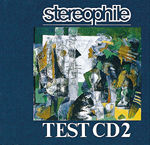| Columns Retired Columns & Blogs |
Editor's Choice: Stereophile's Sampler & Test CD Tracks 1-2
[1] Channel Identification (from Test CD 2, STPH004-2)
[2] Channel Phasing (from Test CD 2, STPH004-2)
[2] Channel Phasing (from Test CD 2, STPH004-2)
Performer: John Atkinson, (1964 Fender Precision Bass guitar fitted with Rotosound round-wound strings), with spoken introduction by Richard Lehnert
Recording Venue: Stereophile's and JA's dedicated listening rooms, Santa Fe, New Mexico
Recording Date: February 1992
Instrument Amplifier: Fender Bassman 50, fitted with ARS tubes, signal feed taken from speaker terminals
Microphone (voice): B&K 4006 omni
Mike Preamp: EAR 824M
A/D Converter: Manley (16-bit) at 44.1kHz
Recorder: Aiwa HD-S1 DAT
 No matter how purist the engineer's approach, all recordings are at least one step removed from the real thing in that the sound has to be picked up by a microphone. An electric instrument, however, allows the opportunity of recording its electrical output without any original sound being produced. In this way, the low-frequency phase integrity of the original "sound" would be preserved absolutely, something audiophile playback systems almost never have to deal with. The result is a reference sound with a high peak:mean ratio, meaning that even though it requires a system with a large dynamic-range capability to be passed through without distortion, it doesn't sound very loud.
No matter how purist the engineer's approach, all recordings are at least one step removed from the real thing in that the sound has to be picked up by a microphone. An electric instrument, however, allows the opportunity of recording its electrical output without any original sound being produced. In this way, the low-frequency phase integrity of the original "sound" would be preserved absolutely, something audiophile playback systems almost never have to deal with. The result is a reference sound with a high peak:mean ratio, meaning that even though it requires a system with a large dynamic-range capability to be passed through without distortion, it doesn't sound very loud.
I decided, therefore, to use a Fender Precision bass guitar for this disc's traditional channel and phasing checks. I ran off a couple of riffs, recording the instrument's output in mono in three different ways: taking a direct feed from the instrument; taking a tap from the Fender Bassman amplifier's output terminals; and, as a check, miking the speaker cabinet. The second version was the one that ended up on the CD, the amplifier's tone controls being used to add a degree of treble bite to the sound and boosting the level of the instrument's bottom octave but not otherwise significantly changing its fundamental character.
What you should hear: Despite what might be thought, the frequency spectra of electric (as opposed to electronic) instruments is complex. The fundamental frequency of the Fender bass's low E string is 41.2Hz, but the second harmonic at 82.4Hz is almost 12dB higher in level!
Significant harmonics extend all the way up to the 17th, at 700Hz, which lies 65dB below the fundamental level; as with any instrument, it is the precise ratio of these harmonics that gives the Fender bass its characteristically woody tone. It is important for a hi-fi system to be able to pass along intact the harmonics of recorded sounds with the ratio of their levels, which corresponds to the "timbre" of the sound.
- Log in or register to post comments




































